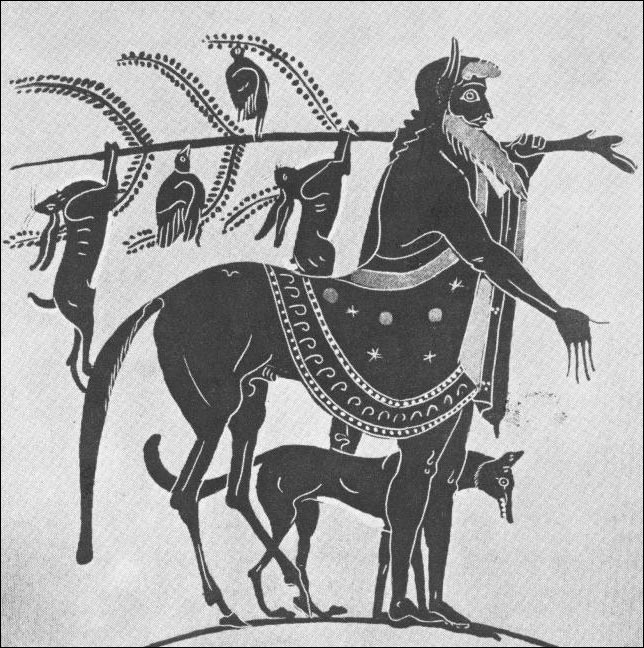 |
Date ca. 520 B.C. Origin The Classical World : Hellenic Era : Greek Archaic Period : Attica Description The centaur Chiron, with dog, bearing with left hand a pine staff across left shoulder on which are hung, birds and hares, his hunting quarry; his right hand before him, his fingers extended downward toward the earth. As Kerényi points out, the trunk of a pine is the usual attribute of centaurs in ancient art (cf. 3Hc.022). At the entrance to the Vale of Tempe to which Apollo came every eight years in the form of a boy to find himself, lay the city of pines, Elateia, with which Elatos (the pine) the centaur, later Lapith, may have been associated. It was in this vale that the pine and the cypress, linked to Apollo in his darker aspects, met, the symbolic value of the northern tree passing over to the southern one. King Phlegyas gave his daughter Keronis, already with child by Apollo, to Psychys, son of the pine. Thus although Elatos and Apollo should have been close, they were in fact rivals. Keronis' child by Apollo is Aesculapius whom the god gives Chiron to care for. When eventually Heracles attempts to hit Elatus with his arrow he hits Chiron instead and the kindly centaur dies. Elatus is at once a tree creature and a centaur. Like Chiron and others of his race he is associated with a dark primeval world. Yet Chiron surpasses his fellows by combining the animal and the Apollonian. Despite his horse's body, mark of the fecund and destructive creature of nature that centaurs are otherwise known to be, he instructs heroes in medicine and music. Aside from him only dark and procreative gods are associated with Cape Malea. Apollo in his role of father of Aesculapius also bore the surname Maleatas, "of Malea". This representation, in combining Chiron as hunter with the pine and the Apollonian Chiron with human forelegs and elegant robe, presents graphically the centaur's special role. We find a strange kinship between Chiron and Apollo calling attention to that dark yet not unspiritual sphere, whence, according to Greek mythology, the art of healing arose. Object Vessel (amphora; black-figure). Style or School Attic. Material or Technique Terra cotta (detail). Image Sources from Kerényi.* [JF 465] References *Kerényi, K., Asklepios (1959), pp.96-100, p.125 n.26; fig.54. Furtwängler, A., Griechische (1932), ser.3., p.239; fig.112. |